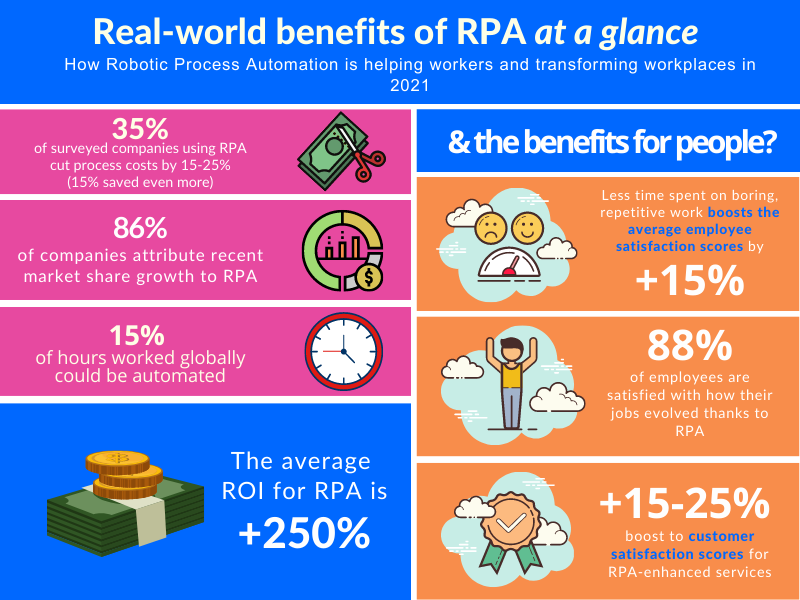Transforming banking ... one RPA at a time
Robotic Process Automation (RPA) is a type of automation that can minic the way a human interacts with a computer. And it’s transforming banking. But this isn’t the first time automation has played a role in the industry’s evolution.
54 years ago, Don Wetsel invented ATMs
Before cashpoints, seeing a teller was the only way to withdraw cash.
As a cash economy, this made things a little difficult – if you missed your chance to withdraw money on a Friday your best hope was to borrow from a friend. Or face staying indoors all weekend.
For Wetzel, waiting in a long teller line was frustrating, so he always got pretty irritated. Until he realised there could be a better way of doing this.
His irritation drove him to invent ATMs: His irritation drove innovation.

This was back in the 1960’s but it tells you everything you need to know about the popularity (and uptake) of RPA in the banking industry.
What can RPA do for banking?
To find out, watch this 2 minute video.
Want to win back your time for high-value tasks
that translate directly into profits?
RPA Software
Appreciation of RPA software in the banking industry is growing fast. This year (2021), annual RPA software revenue has grown by 33% from 2019, coming in at a cool $2 billion. The stats below show you exactly how RPA is benefiting organisations and transforming workplaces at the moment.
3 problems, 1 solution!
After the Covid-19 crisis, the banking industry is facing 3 major challenges:
-
Growing competition from shadow banks and digital entrants
-
Revenue pressure with low profitability
-
Tighter regulations following the last financial crisis
RPA has the solutions
Front Office RPA is helping banks to take the frustration out of slow customer-facing services. With faster services, banks are building loyalty and stopping customers from jumping over to competitors.
Back Office RPA is helping analysts, traders, investors and risk professionals to win back time from low-value admin for more profitable work.
Just look at ATMs
Despite early concerns that automated cash points would put them out of a job, most tellers moved into sales. A great move for the banks, as they could now sell more high-margin products like car insurance, credit cards, investment funds, and mortgages to raise profits. Banks are using that same approach to become more profitable in 2021, just with RPA.
So, how exactly is RPA in the banking industry driving similar levels of innovation? Let’s look at a case study…
Santander X RPA
There are two things successful financial services focus on:
- Convenience
- Quality customer services
Nailing both is how young, digital-native banks like Monzo have disrupted the sector.
Their advantage is their youth – Monzo launched in 2015 as a digital-first bank so their oldest tech is just 6 years old. Which makes it a lot easier for the Monzo's of the world to respond quickly to new customer needs and grow their market share.
But Santander opened way back in 2004, so the legacy tech in their infrastructure is expensive to maintain and risky to change – £2 trillion passes through legacy banking tech every day!
Apart from high-maintenance costs, the biggest challenge of legacy IT in banking is that they're inflexible. That makes innovation quite difficult.
Enter RPA
Inflexible is stable
RPA works best with stable (read: inflexible!) systems.
It’s perfect for managing processes that are repetitive and unlikely to change.
Digital-first disruptors can't always access the same benefits from RPA. Although their modern, fast-changing applications offer agility, it’s tough finding stable workflows to automate.
Santander recognised that as an opportunity to become more competitive and automated 5 customer-facing processes with RPA, including:
RPA in banking car loan applications
Before RPA, Santander processed car loan payments manually. That meant a frustrating delay between customer payments going out and the correct balance showing on their accounts.
With automation, a customers' balance updates right away.
RPA in banking account management
If a customer closed their account, the process took days – which can be a pain for scheduled payments or direct debits.
With RPA, Santander's customers can close their accounts immediately for peace of mind.
RPA in banking loan management
Santander can now process customer requests for a loan payment moratorium instantly.
Using RPA, Santander will re-calculate the loan term payment amount, generate an updated bill and send it to the customer as soon as the request is submitted.
No manual work is required from staff, and there’s no waiting or uncertainty for customers. Faster services = Loyal customers.
With 150 deployed RPA bots
Santander has saved over
30,000 hours
of manual processing time a year
The reduction in manual work and required working hours for staff have resulted in better, faster, and more accurate customer service. And the outcome of becoming customer-centric? Santander started 2021 with its highest quarterly performance in over a decade.

Hi, I'm Alex,
boxxe's Automation Specialist.
Ask me anything about the impact that Robotic Process Automation can have on your bank











